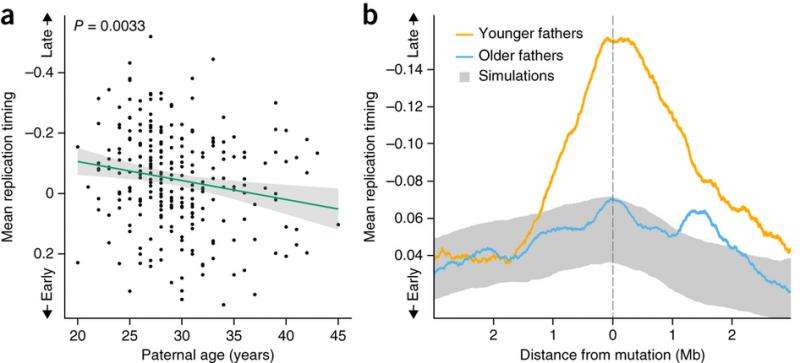Mutations in the offspring of younger fathers are biased toward later-replicating regions. Credit: (c) 2015 Nature Genetics (2015) doi:10.1038/ng.3292
(Medical Xpress)—A large team of researchers with members from the Netherlands and the U.S. has conducted a genome analysis on a large human population and as a result has found patterns and properties that were not formerly known regarding de novo mutations. In their paper published in Nature Genetics, the team describes the study they conducted, their findings and the map they created using the data they had obtained.
De novo mutations are non-generational mutations that occur in human sperm or egg cells or in a fertilized egg—they are not believed to be inherited, thus they are considered to be present for the first time in one of the parents or the fertilized egg. Such mutations tend to lead to variations in a population, which drives evolution but they can also be the cause of some genetic diseases. In order to better understand how often they occur, the researchers obtained health data records from 250 families, which included 231 trios (mother, father and child) and multiple instances of both monozygotic and dizygotic twins—and in so doing found 11,000 instances of de novo mutations. The researchers describe it as the most extensive catalog of de novo mutations in humans to date.
In analyzing the data, the researchers found that de novo mutations occurred more frequently in fathers that were older and also occurred more frequently in early-replicating, genic regions. They also noted that many of the mutations appeared to be related to replication timing in germline cells, while others tended to be found clustered in functional regions—this the team suggests, indicates that a new mutagenic mechanism is likely at work. The replication timing mutations, the team noted, were generally associated with paternal age—the results were based on factoring in the maternal age.
The team also created a genome map based on mutation rates (by applying human/chimpanzee divergence rates as well as sequencing contexts, types of mutations found, which strands most often were impacted, etc.) for use by medical personnel and other researchers looking to prevent genetic diseases. They believe their study has revealed new insights into de novo mutations and has refined what has previously been discovered regarding mutagenesis.
More information: Genome-wide patterns and properties of de novo mutations in humans, Nature Genetics (2015) DOI: 10.1038/ng.3292
Abstract
Mutations create variation in the population, fuel evolution and cause genetic diseases. Current knowledge about de novo mutations is incomplete and mostly indirect. Here we analyze 11,020 de novo mutations from the whole genomes of 250 families. We show that de novo mutations in the offspring of older fathers are not only more numerous but also occur more frequently in early-replicating, genic regions. Functional regions exhibit higher mutation rates due to CpG dinucleotides and show signatures of transcription-coupled repair, whereas mutation clusters with a unique signature point to a new mutational mechanism. Mutation and recombination rates independently associate with nucleotide diversity, and regional variation in human-chimpanzee divergence is only partly explained by heterogeneity in mutation rate. Finally, we provide a genome-wide mutation rate map for medical and population genetics applications. Our results provide new insights and refine long-standing hypotheses about human mutagenesis.
Journal information: Nature Genetics
© 2015 Medical Xpress





















